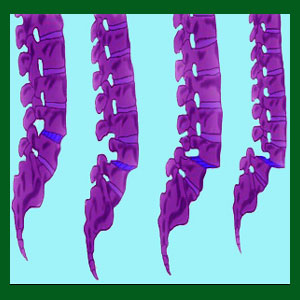
There are several possible spondylolisthesis causes, including congenital defects, injury and advanced spinal degeneration. Listhesis conditions can generally be traced to definitive causative circumstances, although some cases are still ruled to be idiopathic in exceptional cases.
Recognizing a verified causative process for any back pain syndrome is one of the most important steps in effectively treating the problem. In this regard, spondylolisthesis patients usually have a distinct advantage when seeking care compared to other dorsalgia sufferers. However, it must be made clear that most cases of listhesis are not painful and will not necessarily become painful, even as they progress. Most cases merely require medical monitoring, rather than active treatment. In fact, spondylolisthesis treatment is one of the most commonly cited reasons for symptomatic commencement or escalation.
This resource section explains the various causative mechanisms for listhesis. We will discuss how a variety of scenarios can lead to spondylolisthesis of different types and how the circumstances of causation can influence progression and symptomology.
Possible Spondylolisthesis Causes
Some cases of listhesis are idiopathic in nature, which means that they exist for no known or verified cause. Some cases might involve theories regarding causation, while others are truly enigmatic. However, these instances represent the minority of listhesis circumstances. Most listhesis case profiles can be traced to definitive source processes.
Spondylolisthesis can be classified as belonging to 2 different varieties. The first is congenital type, which describes conditions that either exists before birth or cases that develop due to congenital abnormalities expressed before birth. The second is the developed variety, wherein vertebral slippage occurs due to circumstances that occur during life, such as injury, surgery or structural aging of the spinal tissues.
Many scientists believe that many cases of listhesis can be linked to congenital abnormalities, even if these abnormalities can not be clearly defined or identified. Many doctors also believe that there is a major genetic component as to who will develop listhesis and who will not, including both congenital and developed types of vertebral migration.
Specific Causes of Listhesis
The following articles each provide a detailed glimpse at particular causative circumstances for specific types of listhesis. As each new essay is published, it will be added to the list below:
Spondylolysis is the medical diagnostic term for injury or defect affecting the pars interarticularis, which facilitates the most common type of listhesis, called the isthmic variety of vertebral slippage.
Fractured vertebra spondylolisthesis usually affects the pars, as well, but can also involve other structures in less common circumstances.
Congenital spondylolisthesis can affect several different tissues, predisposing the person to develop vertebral migration prior to birth.
Spondylolisthesis from injury is a common circumstance in athletic individuals, postoperative patients and even elderly persons who might demonstrate spinal fragility due to bone porosity issues.
Hypermobile joints and spondylolisthesis often are found in patients, since hypermobility tends to allow the vertebral bones a larger than normal range of motion that can lead to permanent migration.
Summation of Spondylolisthesis Causes
Successful treatment of many types of listhesis relies heavily on identifying and resolving the causative process. In other words, not all spondylolisthesis responds to treatment in the same way. The more information that the care team can gather about the causative mechanism for the vertebral slippage, the better treatment results might be. Although it does not help patients much to know where their listhesis comes from, it might give them peace of mind or even assist in circumstance-specific matters, such as litigation.
Spondylolisthesis seems to have genetic markers that show themselves in each generation or in patterned formations sometimes affecting specific members of a bloodline based on gender, age or generation of birth. This mirrors other spinal conditions, such as scoliosis, and is a subject of intense scrutiny by doctors and research scientists alike. After all, if the genetic markers for listhesis can be successfully isolated, there might be a way of preventing them from being passed on to the next generation, breaking the cycle of spinal abnormality in the lineage of the family tree.
Our Cure Back Pain Forever Program can resolve pain due to many causes and has been praised by doctors and healthcare organizations worldwide for its efficacy.
Spondylolisthesis > Spondylolisthesis Causes



